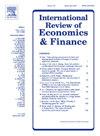Systemic risk contagion and bailout effects in the global financial system
IF 4.8
2区 经济学
Q1 BUSINESS, FINANCE
引用次数: 0
Abstract
This paper contributes to the finance literature by investigating the risk contagion and bailout effects in the global financial system. We use the bilateral exposure matrix to examine the impact of credit shocks and liquidity shocks on the global financial system when a Global Systemically Important Bank (G-SIB) is supposed to be in distress. The findings indicate that the global financial network is dominated by large and medium-sized financial institutions. Credit shocks does not play a significant role in risk contagion nor do they trigger the systemic risk in the global financial system. However, the global financial network is more vulnerable to liquidity shocks than to credit shocks. If a credit shock and liquidity shock overlaps with each other, the hybrid shock can exacerbate the risk contagion effects and lead to rapid propagation throughout the global financial network. If a regulator bails out the distressed institutions, the bailout efficiency increases with the number of rescued institutions. However, the improvement in of bailout efficiency decreases with the number of rescued institutions. If a regulator can promote financial institutions to raise the rollover ratio, the financial system will be more robust to shocks. This paper provides a ground view of systemic risks contagion and sheds light on directions for future research on systemic risk contagion in the global financial system.
全球金融体系中的系统性风险传染和救助效应
本文通过研究全球金融体系中的风险传染和救助效应,为金融文献做出贡献。我们使用双边风险敞口矩阵来检验当全球系统重要性银行(G-SIB)陷入困境时,信贷冲击和流动性冲击对全球金融体系的影响。研究结果表明,全球金融网络以大中型金融机构为主。信贷冲击在风险传染中不发挥重要作用,也不会引发全球金融体系的系统性风险。然而,与信贷冲击相比,全球金融网络更容易受到流动性冲击的影响。如果信贷冲击和流动性冲击相互重叠,则混合冲击会加剧风险传染效应,并在全球金融网络中迅速传播。如果监管机构救助陷入困境的机构,救助效率会随着救助机构数量的增加而提高。然而,随着被救助机构数量的增加,救助效率的提高幅度逐渐减小。如果监管机构能够推动金融机构提高展期比率,金融体系将更能抵御冲击。本文提供了系统性风险传染的基础观点,并为未来全球金融体系系统性风险传染的研究指明了方向。
本文章由计算机程序翻译,如有差异,请以英文原文为准。
求助全文
约1分钟内获得全文
求助全文
来源期刊
CiteScore
7.30
自引率
2.20%
发文量
253
期刊介绍:
The International Review of Economics & Finance (IREF) is a scholarly journal devoted to the publication of high quality theoretical and empirical articles in all areas of international economics, macroeconomics and financial economics. Contributions that facilitate the communications between the real and the financial sectors of the economy are of particular interest.

 求助内容:
求助内容: 应助结果提醒方式:
应助结果提醒方式:


